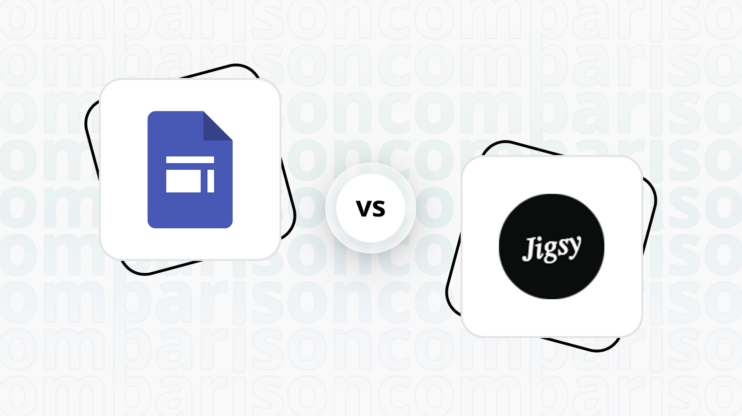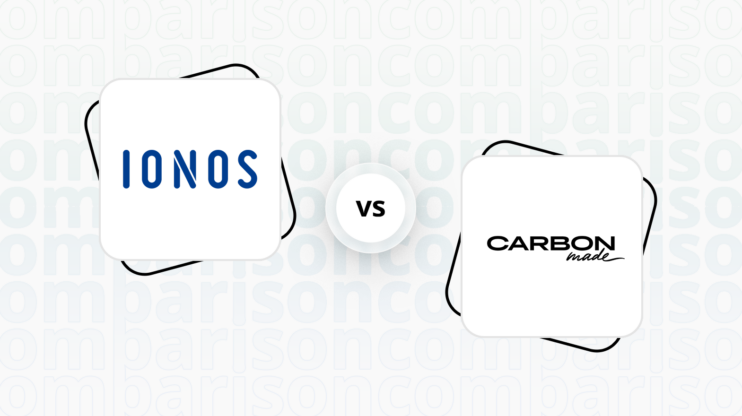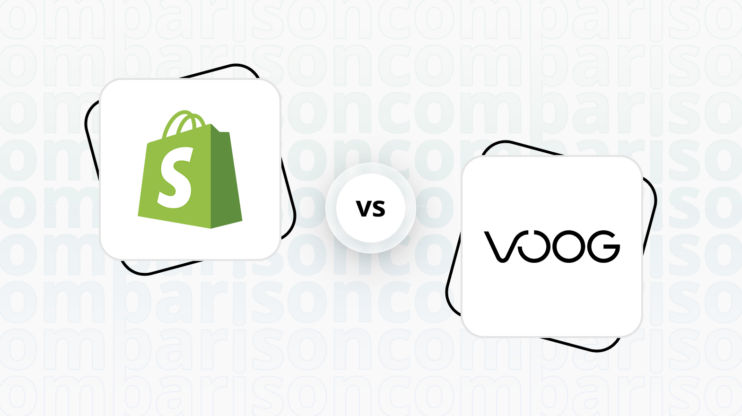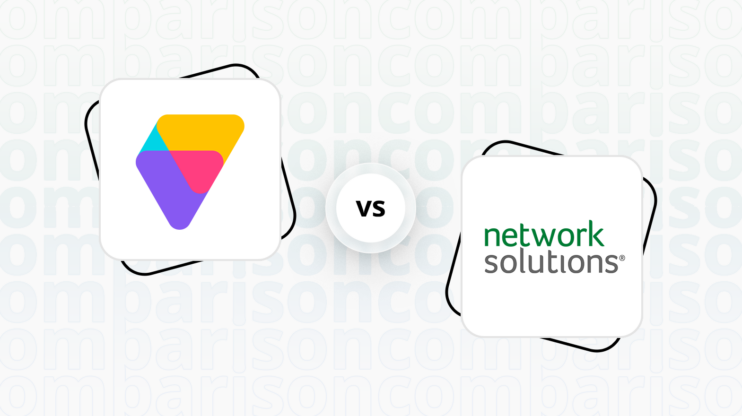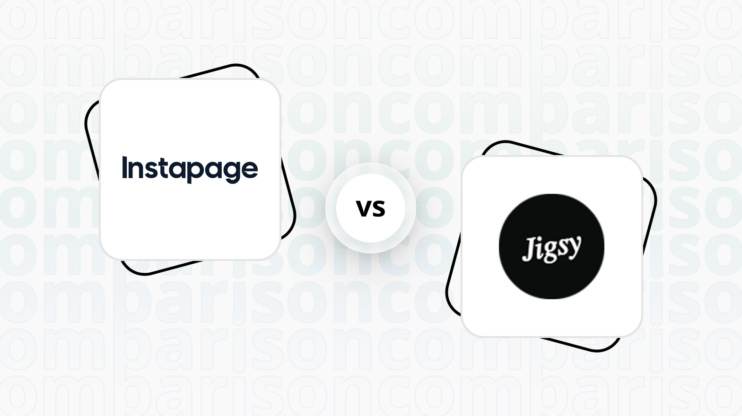Final verdict
Webflow and BigCommerce both offer robust platforms, but they cater to different user needs and preferences.
-
Webflow (Overall Grade: 7.9/10)
is ideal for professional designers and developers who seek extensive design flexibility and control. It excels in providing a powerful design experience with a wide array of templates and customization options. Webflow’s visually intuitive interface and advanced design tools make it a preferred choice for creating custom, responsive websites. However, it has a steeper learning curve and may not be as user-friendly for beginners. -
BigCommerce (Overall Grade: 7.9/10)
is a comprehensive ecommerce platform that stands out for its built-in features, advanced SEO tools, and multi-channel selling capabilities. It is particularly well-suited for businesses looking to scale their online presence. BigCommerce offers a user-friendly interface, extensive support resources, and robust ecommerce functionalities, making it a popular choice for merchants. However, it may lack some design flexibility compared to Webflow.

|

|
|
|---|---|---|
|
Design functionalities & templates |
8.6 |
7.8 |
|
Ease of use |
7.5 |
7.3 |
|
Ecommerce |
8.5 |
9.0 |
|
Website Editors |
9.0 |
7.9 |
|
Product testing options |
6.3 |
7.3 |
|
Price |
8.0 |
7.4 |
|
Hosting quality |
8.9 |
7.8 |
|
Website speed optimization |
8.1 |
7.6 |
|
Plugins and integrations |
5.5 |
7.7 |
|
Marketing features |
7.8 |
7.9 |
|
Customer support |
8.3 |
8.7 |
|
Security |
7.8 |
8.9 |
|
AI capabilities |
8.3 |
7.3 |
|
User Management |
8.3 |
8.9 |
Best for ecommerce
 8.5
8.5
 9.0
9.0
Verdict
: BigCommerce slightly outperforms Webflow in the ecommerce sector, making it a better choice for businesses looking for a comprehensive and scalable ecommerce solution.
-
Webflow
: Webflow is a robust platform for creating online stores, offering comprehensive ecommerce features such as easy store creation without coding, extensive customization options, and product management with variations. It is ideal for professional designers and those who need a high level of design flexibility. However, when comparing Webflow vs BigCommerce, Webflow may not offer the same level of built-in ecommerce functionalities and scalability as BigCommerce. -
BigCommerce
: BigCommerce is a comprehensive ecommerce platform known for its robust set of built-in features, including advanced SEO tools, various payment gateway integrations, and multi-channel selling capabilities. It supports unlimited products, streamlined single-page checkout, and extensive marketing and sales tools, making it a popular choice for merchants looking to scale their online presence. In the Webflow vs BigCommerce comparison, BigCommerce stands out for its superior ecommerce capabilities and flexibility in payment processing.
Best for informational & business websites
 8.6
8.6
 7.5
7.5
Verdict
: Webflow is the superior choice for creating informational and business websites, thanks to its powerful design tools and flexibility. BigCommerce, while robust for ecommerce, doesn’t match Webflow’s capabilities in this area.
-
Webflow
: Webflow excels in providing a comprehensive solution for creating custom, responsive websites. Its powerful design tools and flexible CMS make it ideal for professional designers and businesses looking to create visually stunning and highly functional informational sites. With a score of 8.6, Webflow stands out for its design flexibility and top-tier hosting services. -
BigCommerce
: BigCommerce, scoring 7.5, is primarily an ecommerce platform but offers a range of customizable templates and design options. While it provides robust features for online stores, it may not be as suitable for purely informational websites. When comparing Webflow vs BigCommerce, BigCommerce’s strengths lie in its ecommerce capabilities rather than in creating informational sites.
Detailed comparison
Design functionalities & templates
Design FunctionalitiesRepresents how well each platform allows for creative design and customization of websites.Score Components:
- Template Variety (30%): Range and quality of design templates.
- Customization (30%): Flexibility and options for design alterations.
- User Interface (20%): Ease and intuitiveness of the design process.
- Responsiveness (10%): Adaptability to different devices and screen sizes.
- Innovation (10%): Unique design features and tools.
 8.6
8.6
 7.8
7.8
🏆
Winner: Webflow.
If you’re looking for a platform that offers more creative control and a wide array of design features, Webflow is the preferred choice.
Webflow delivers a robust design experience with a diverse range of template and customization options. Boasting over 1000 pre-built templates covering various industries and website types, including free and premium options, Webflow ensures a constantly evolving library for users. Templates are categorized for easy browsing, considering industry, website type, style, and features. The design customization features include a visual drag-and-drop editor for real-time adjustments, fine-grained control over every aspect of the design, and the ability to inject custom code for advanced users seeking additional personalization and unique functionalities.
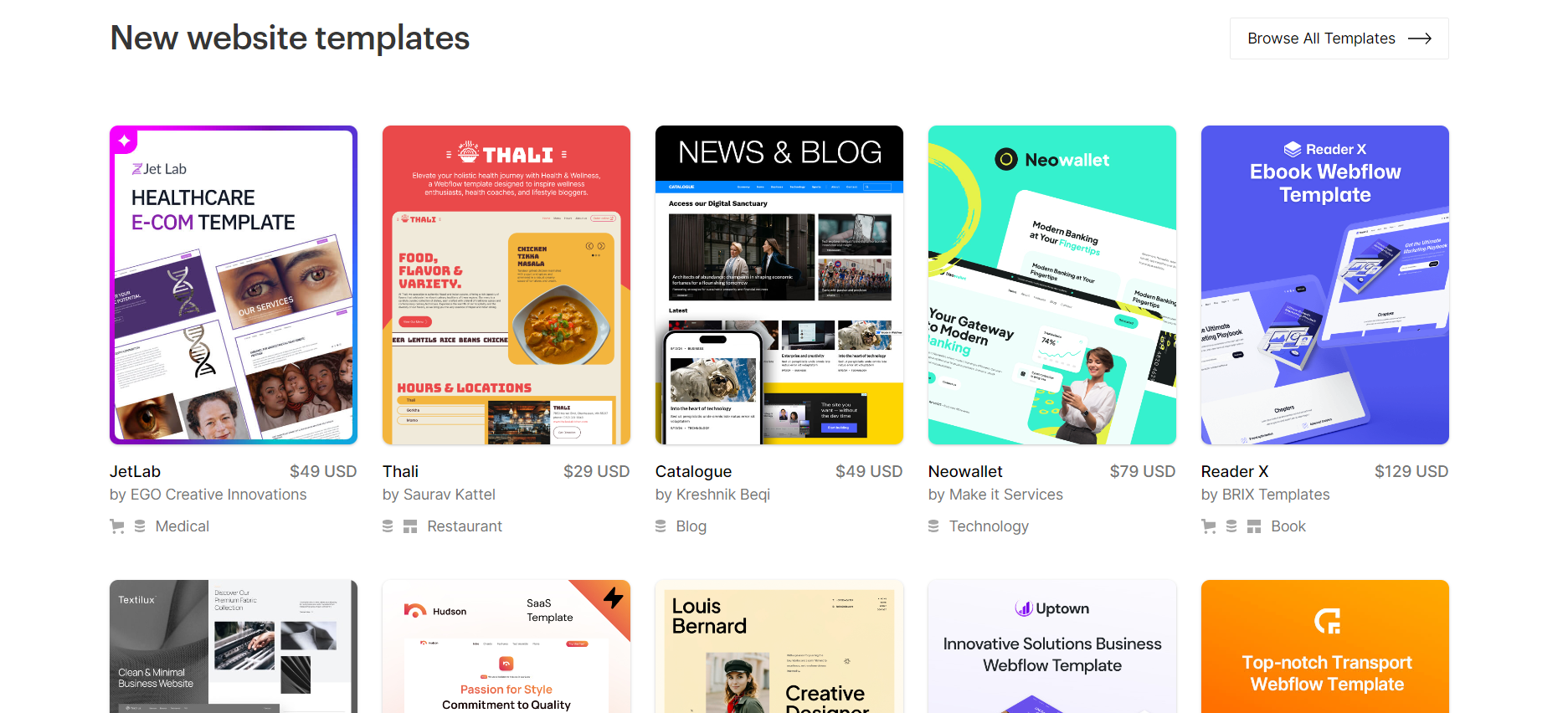
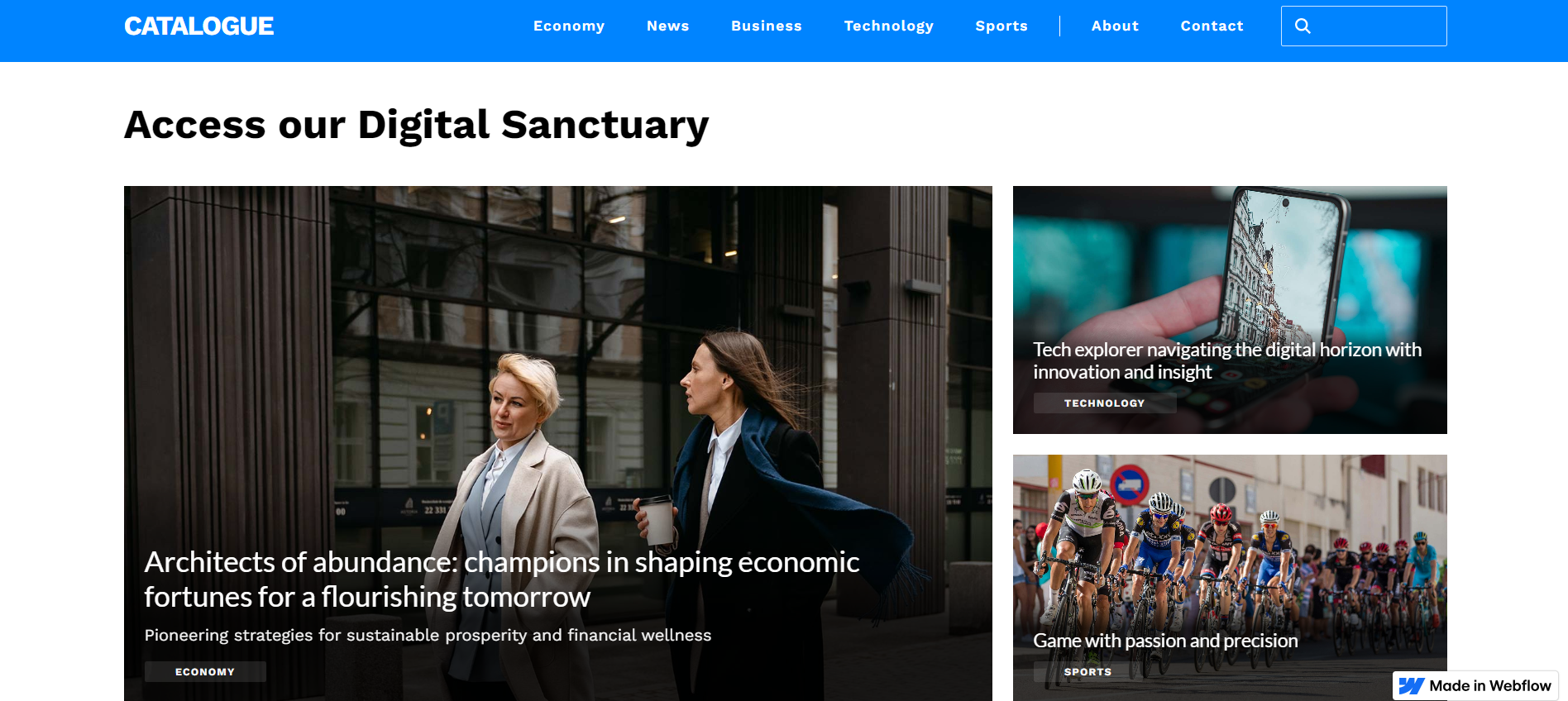
Compared to Webflow, BigCommerce offers a variety of design templates for creating ecommerce websites, with a total of 240 themes available. Most of these themes come with up to four styling options, providing users with flexibility in design choices to match their brand’s aesthetic. There are 12 free themes, while the rest range in price from $150 to $300 each.
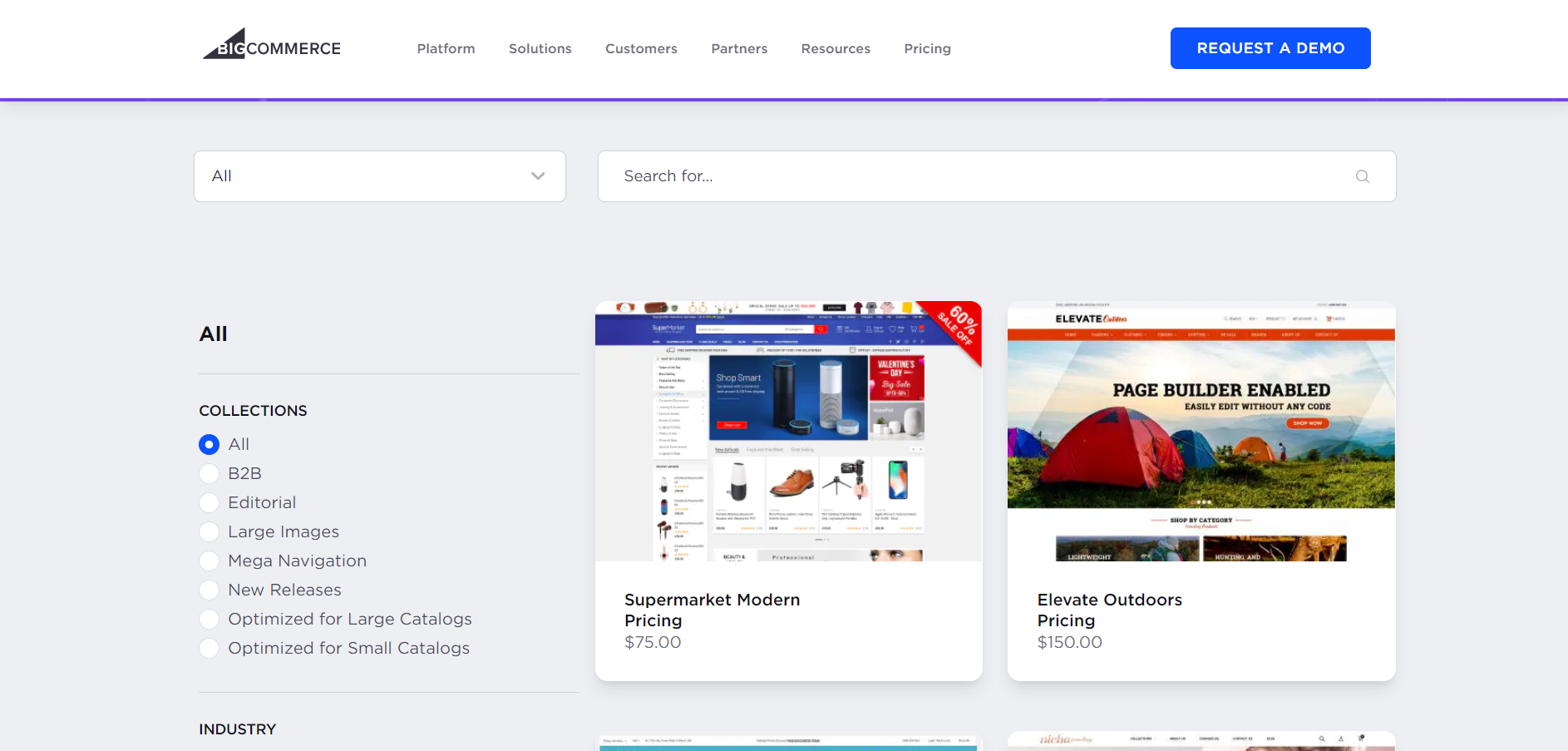
Get a head start on website creation with AI
Create a custom website tailored to your business needs 10X faster with 10Web AI Website Builder!
Ease of use
Ease of useReflects the platform’s overall user-friendliness.Score
Components:
- Learning curve (40%): Quickness and ease of getting started.
- Interface design (30%): Simplicity and intuitiveness of layout.
- User guidance (20%): Quality of tutorials and support.
- Flexibility (10%): Adaptability to various user skills.
 7.5
7.5
 7.3
7.3
🏆 Winner: Webflow
. Scoring a 7.5, Webflow edges out BigCommerce, which scored a 7.3. While both platforms are user-friendly, Webflow’s visually intuitive interface and design flexibility make it slightly more appealing, especially for experienced designers and developers. However, beginners may find Webflow challenging due to a steeper learning curve.
Learning Resources
🏆 Winner: Tie
. Both Webflow and BigCommerce offer comprehensive learning resources. Webflow provides diverse courses and tutorials through Webflow University and its YouTube Channel, while BigCommerce offers a wide range of materials, including articles, guides, webinars, and specific training through BigCommerce University.
For ecommerce
EcommerceMeasures the platform’s effectiveness in supporting online business activities.Score Components:
- Ecommerce themes and templates (20%): Variety and design of templates.
- Product management (25%): Ease of managing and organizing products.
- Payment options (25%): Variety and convenience of payment methods.
- Ecommerce features (20%): Features for managing an ecommerce store.
- Integration (10%): Compatibility with external e-commerce tools and services.
 8.5
8.5
 9.0
9.0
BigCommerce, with a score of 9.0, slightly edges out Webflow, which has a score of 8.5, in the ecommerce sector. BigCommerce is a comprehensive ecommerce platform known for its robust set of built-in features, including advanced SEO tools, various payment gateway integrations, and multi-channel selling capabilities. On the other hand, Webflow is a robust platform for creating online stores, offering comprehensive ecommerce features such as easy store creation without coding, extensive customization options, and product management with variations.

|

|
|
|---|---|---|
|
Ecommerce themes and templates |
7.5 |
8.0 |
|
Product page customization |
8.3 |
8.3 |
|
Payment processing and commissions |
7.8 |
9.2 |
|
POS capabilities |
6.5 |
8.5 |
|
Payment gateways |
8.0 |
9.0 |
|
Product numbers |
7.0 |
9.5 |
|
Additional ecommerce features |
7.9 |
8.4 |
Webflow ecommerce features:
- Checkout and Payment Processing with Stripe, PayPal, etc.
- Marketing and Promotions
- Tax and Shipping calculations
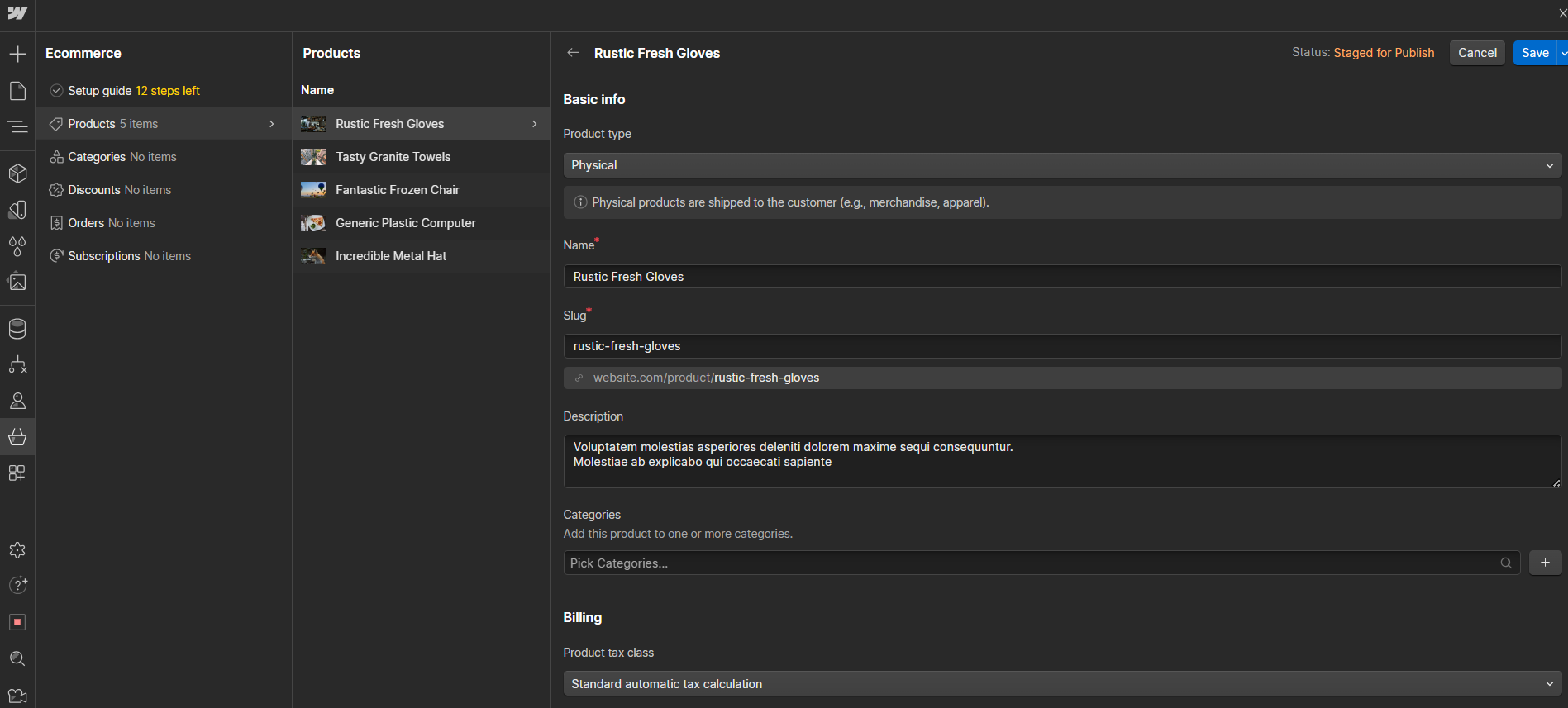
BigCommerce ecommerce features:
- Unlimited Products
- Streamlined Single-Page Checkout
- Order Management
- Abandoned Cart Recovery
- Marketing and Sales Tools

Ecommerce themes & templates
Webflow offers a diverse range of ecommerce themes and templates designed to cater to various types of online stores, from fashion and technology to artisan crafts and children’s products. Each template comes equipped with built-in ecommerce functionality, allowing you to easily add products and manage your store without the need for coding. BigCommerce provides a wide variety of eCommerce templates designed to enhance online shopping experiences and cater to different industries. These templates feature advanced functionalities like quick view, product suggestions, and complex search filters but may require performance optimization for maintaining speed.
Product page customization
Webflow offers extensive customization options for eCommerce product pages, allowing users to design and personalize their pages without coding. It provides tutorials for creating product pages from scratch, offers responsive templates for various devices, and allows users to add custom code and dynamic content using Webflow’s CMS for maximum customization flexibility. In BigCommerce, you can extensively customize product pages to enhance customer experience and improve sales. This includes the ability to create detailed product variants, customize options like custom fields, and upload multiple images or videos for each product.
Payment processing
Webflow provides a flexible and secure platform for payment processing and ecommerce through integrations with leading payment gateways like Stripe and PayPal. This allows users to accept a wide range of payments, including credit card transactions directly from their websites. BigCommerce supports over 65 pre-integrated online payment solutions, serving customers across 230 countries with more than 140 currencies, without charging additional transaction fees for using third-party payment gateways. This approach provides merchants with the flexibility to choose the best payment solution for their business needs, including the option for custom integration to cater to specific regional payment preferences.
Website Editors
Website EditorsEvaluates the platforms’ website building and editing capabilities.Score Components:
- Customization tools (40%): Range and power of editing features.
- Editor usability (30%): User experience within the editor.
- Design flexibility (20%): Freedom in layout and design changes.
- Update and maintenance ease (10%): Simplicity of updating and maintaining the site.
 9.0
9.0
 7.9
7.9
🏆
Winner: Webflow
. Webflow, with a score of 9.0, is a cloud-based platform that combines web design, CMS, and hosting, enabling users to visually design responsive websites without writing code. It offers a drag-and-drop interface, integrated SEO tools, ecommerce functionalities, and the ability to add animations and interactions, making web development accessible for designers and powerful for developers. Webflow streamlines the process of web creation, from design to launch, offering both high customization and ease of use.
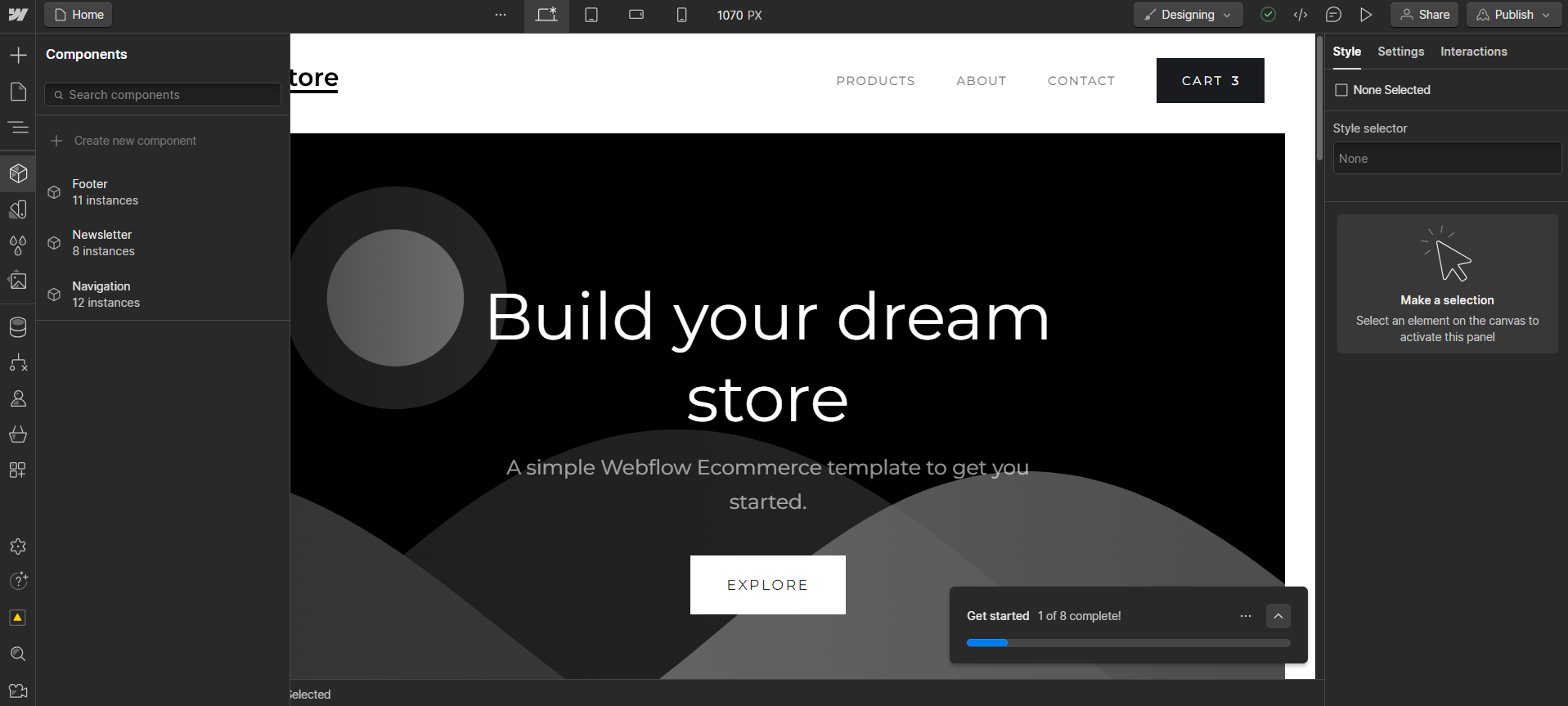
BigCommerce’s website builder and editor, scoring 7.9, offer an extensive set of tools designed for creating professional and engaging online stores without requiring coding knowledge. It provides a user-friendly drag-and-drop interface, robust eCommerce capabilities including product management and secure payment processing, and customizable templates to match brand aesthetics. The platform also features powerful SEO and marketing tools, app integrations for extended functionality, and comprehensive analytics to track website performance. These features make it an ideal solution for businesses of all sizes looking to establish or expand their online presence.
Mobile editor/app
 7.0
7.0
 7.5
7.5
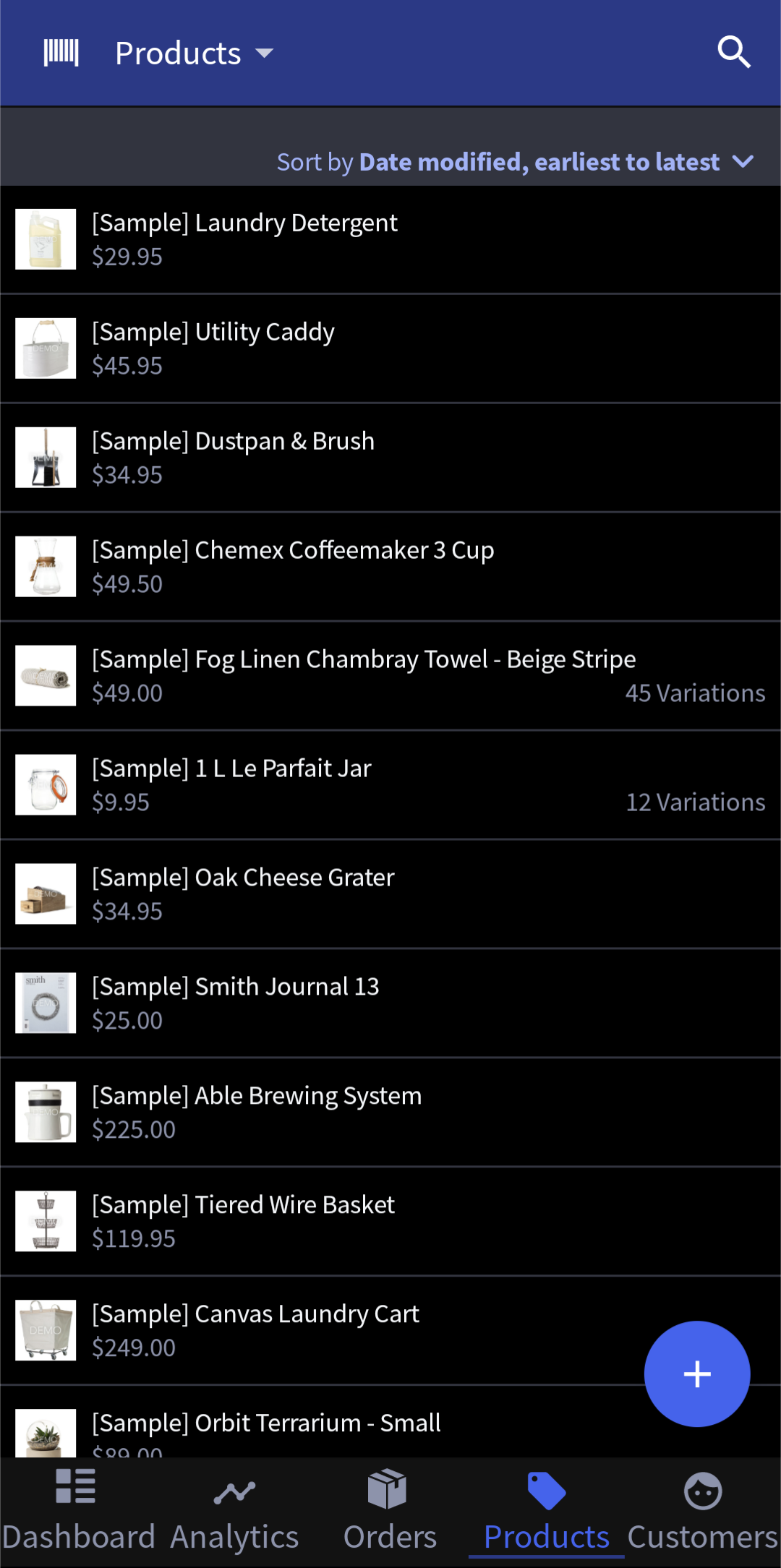
🏆
Winner: BigCommerce
. Both Webflow and BigCommerce have limitations when it comes to mobile editing. Webflow does not have an official mobile editor app, but there is a third-party app called EditFlow, which is only available for iOS. On the other hand, BigCommerce does have a mobile app, but it does not allow users to edit the website itself. Instead, it provides access to the dashboard, analytics, orders, and the ability to add or edit products.
Despite these limitations, BigCommerce scores slightly higher than Webflow in the mobile editor category, making it the winner in this comparison.
Product testing options
Product Testing OptionsAssesses the options for trying out platform features before commitment.Score Components:
- Trial quality (40%): Extent and usefulness of the trial or free version.
- Feature accessibility (30%): How many features are available to test.
- Trial duration (20%): Length of the trial period.
- Ease of transition (10%): Smoothness of moving from trial to paid plans.
 6.3
6.3
 7.3
7.3
Overall Result
:
BigCommerce Wins
. BigCommerce scores 7.3, higher than Webflow’s 6.3, in product testing options. BigCommerce offers a 14-day free trial during which users can test premium features. Webflow, on the other hand, offers a free plan with basic features but does not provide a trial version or the possibility to test premium features.

|

|
|
|---|---|---|
|
Free Plan |
Yes |
No |
|
Trial Duration |
No |
14 days |
|
Testing Premium Features |
Basic features with free plan |
During free trial |
Price
PriceLooks at the cost-effectiveness and value for money of each platform.Score Components:
- Plan value (40%): What each pricing tier offers.
- Transparency and clarity (30%): Clearness of pricing structures.
- Flexibility of plans (20%): Range of options to suit different budgets.
- Hidden costs (10%): Additional expenses not included in the plan.
 8.0
8.0
 7.4
7.4
Webflow and BigCommerce both offer a range of price plans to suit different needs, with Webflow generally scoring higher in terms of price.

|

|
|
|---|---|---|
|
Free |
Starter (Free): Limited features for new sites, including 2 static pages and 50 form submissions lifetime. |
No offering at this amount. |
|
$10-$20 |
Basic ($18/month): Suitable for simple sites with a custom domain, including basic SEO controls and 500 monthly form submissions. And 100 pages. Value for price: 6.5 |
No offering at this amount. |
|
$20-$30 |
CMS ($29/month): For content-driven sites with 2,000 CMS items, 1,000 monthly form submissions, and full API access. And 150 website pages. Value for price: 7.5 |
No offering at this amount. |
|
$30-$45 |
Standard ($42/month): For new businesses with up to 500 ecommerce items, includes basic ecommerce features, and 2% transaction fee Value for price: 8.5 |
Standard ($39.00/month): Unlimited products, file storage, and bandwidth, suitable for small businesses. Limited to $50k in online sales per year and up to 4 inventory locations. Value for price: 7.0 |
|
$45-$50 |
Business ($49/month): High traffic capacity, advanced features like site search, and up to 10 content editors. Value for price: 8.0 |
No offering at this amount. |
|
$80-$110 |
Plus ($84/month): Higher volume businesses with 0% transaction fees, up to 5,000 ecommerce items, and advanced features. Value for price: 9.0 |
Plus ($105.00/month): Includes Standard features, plus customer segmentation and abandoned cart saver. Limited to $180k in online sales per year and up to 5 inventory locations. Value for price: 7.5 |
|
$200+ |
Advanced ($235/month): Scalable solution for large online stores with up to 15,000 ecommerce items and the highest caps and 0% transaction fees. Value for price: 9.5 |
Pro ($399.00/month): All Plus features, plus Google customer reviews and advanced search filters. Limited to $400k in online sales per year, and up to 8 inventory locations. Additional $150/month for every $200k in online sales. Value for price: 8.0 |
location. As a result in rare cases the prices displayed here can differ from the ones you see on their
websites.
Hosting quality
Hosting
qualityExamines the reliability and performance of the hosting solutions.Score Components:
- Uptime (40%): Consistency and reliability of website availability.
- Speed (30%): Loading times and performance.
- Bandwidth and storage (20%): Sufficiency of resources provided.
- Data centers (10%): Quality and distribution of hosting infrastructure.
 8.9
8.9
 7.8
7.8
🏆
Winner: Webflow
Webflow offers managed hosting with a 99.99% uptime, and it leverages a globally distributed network of data centers from Amazon Web Services (AWS) and Fastly. BigCommerce, on the other hand, provides cloud hosting with a 99.9% uptime, but does not disclose the locations of its data centers. While both platforms offer robust hosting services, Webflow’s higher uptime and transparency about its data centers give it the edge.

|

|
|
|---|---|---|
|
Do they offer hosting? |
Yes, included in all of their plans |
Yes, scalable cloud hosting, with unlimited storage and bandwidth, but limited backup possibilities |
|
Data Centers: |
Webflow doesn’t actually have its own data centers. Instead, it relies on a globally distributed network of data centers from Amazon Web Services (AWS) and Fastly. |
BigCommerce does not disclose the locations of its data centers |
|
Type of hosting: |
Managed Hosting |
Cloud Hosting |
|
Uptime: |
99.99% |
99.9% |
|
Uptime Guarantee: |
Only Enterprise plan, 99.99% |
Yes, 99.99% |
Website Speed Optimization
Website Speed OptimizationEvaluates optimization of website loading timesScore Components:
- PageSpeed Score (30%): Google’s score indicating performance optimization.
- Loading Time (30%): The average time until a website is fully interactive.
- Mobile Optimization (15%): Optimization effectiveness for mobile devices.
- Resource Optimization (15%): Optimizing images, scripts, and other heavy resources.
- CDN Usage (10%): Use of CDN to enhance speed across geolocations.
 8.1
8.1
 7.6
7.6
🏆 Winner: Webflow
Both Webflow and BigCommerce prioritize website performance and page speed, but Webflow takes the lead with its custom cache settings, custom element lazy loading, automatic minification, responsive templates, and CDN.

|

|
|
|---|---|---|
|
Focus |
Custom Cache Settings, Custom Element Lazy Loading, Automatic Minification, Responsive templates, CDN |
Image Optimization, Code minification, Optimized templates, Using AMP, Caching |
|
Performance Tools |
Google Lighthouse, PageSpeed Insights |
Google PageSpeed Insights Integration |
|
Key Strategies |
Custom Cache Settings, Custom Element Lazy Loading, Automatic Minification, Responsive templates, CDN |
Image Optimization, Code minification, Optimized templates, Using AMP, Caching |
|
Load Times |
Below 2 seconds average |
Varies depending on optimization and website complexity |
|
Page Speed Scores Range |
77.2/100 |
Varies depending on optimization and website complexity |
|
Core Web Vitals Improvement |
Improving components’ usability, and emphasis on LCP, FID and CLS |
Provides users with many tools for CVW improvements |
Webflow’s approach to enhancing site speed includes custom cache settings, custom element lazy loading, automatic minification, responsive templates, and CDN. This approach leverages Webflow’s fast servers and CDN network to boost load speed. Webflow also focuses on improving components’ usability and places emphasis on LCP, FID, and CLS. The average load time for Webflow websites is below 2 seconds, and the average PageSpeed score is 77.2/100.
BigCommerce, like Webflow, places a strong emphasis on website performance and page speed. BigCommerce’s approach to enhancing site speed includes image optimization, code minification, optimized templates, using AMP, and caching. However, the load times and PageSpeed scores for BigCommerce websites vary depending on optimization and website complexity. BigCommerce provides users with many tools for CVW improvements of their websites.
Get a head start on website creation with AI
Create a custom website tailored to your business needs 10X faster with 10Web AI Website Builder!
Plugins and integrations
Plugins and integrationsMeasures the range and effectiveness of additional plugins and integrations.Score Components:
- Variety of options (40%): Range of available add-ons.
- Integration smoothness (30%): Ease of integrating plugins into the site.
- Quality of plugins (20%): Functionality and reliability of the options.
- Custom integration capabilities (10%): Support for custom or third-party integrations.
 5.5
5.5
 7.7
7.7
🏆 Winner: BigCommerce.
With a score of 7.7, BigCommerce offers a wide array of apps and integrations, including ERP and CRM systems, 3PL services, POS systems, and various marketing tools, to enhance eCommerce functionalities. These integrations facilitate operations like sales analytics, inventory management, customer relationship management, and marketing automation.
On the other hand, Webflow, with a score of 5.5, doesn’t have plugins or extensions in the traditional sense. Instead, it offers a built-in library of website elements and functionalities that you can use to create your website. This library is constantly being expanded, so you’ll always have access to the latest features and tools. However, Webflow does integrate with a number of third-party services and tools that can add even more functionality to your website. These integrations are not managed by Webflow, so the number of available options and their pricing structures can vary depending on the specific tools you choose.
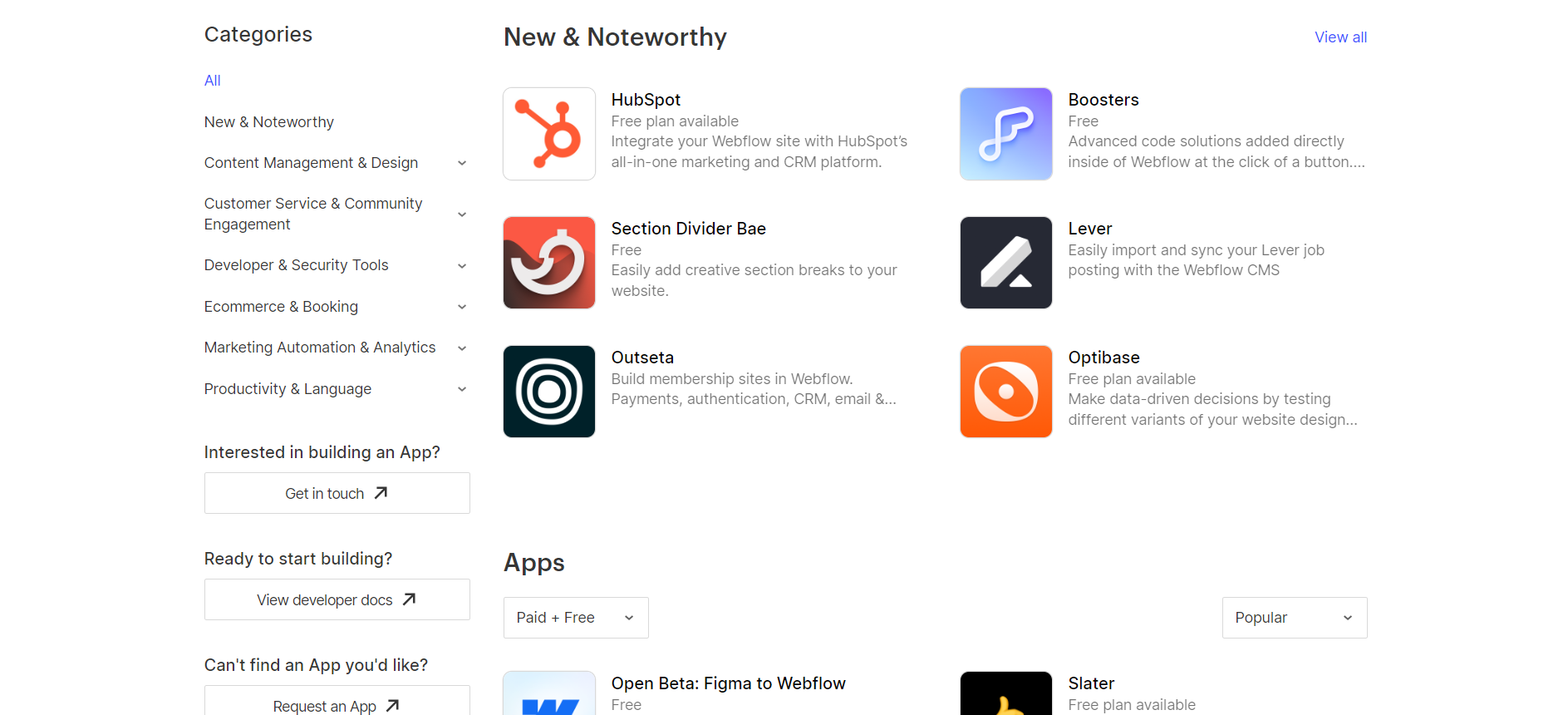
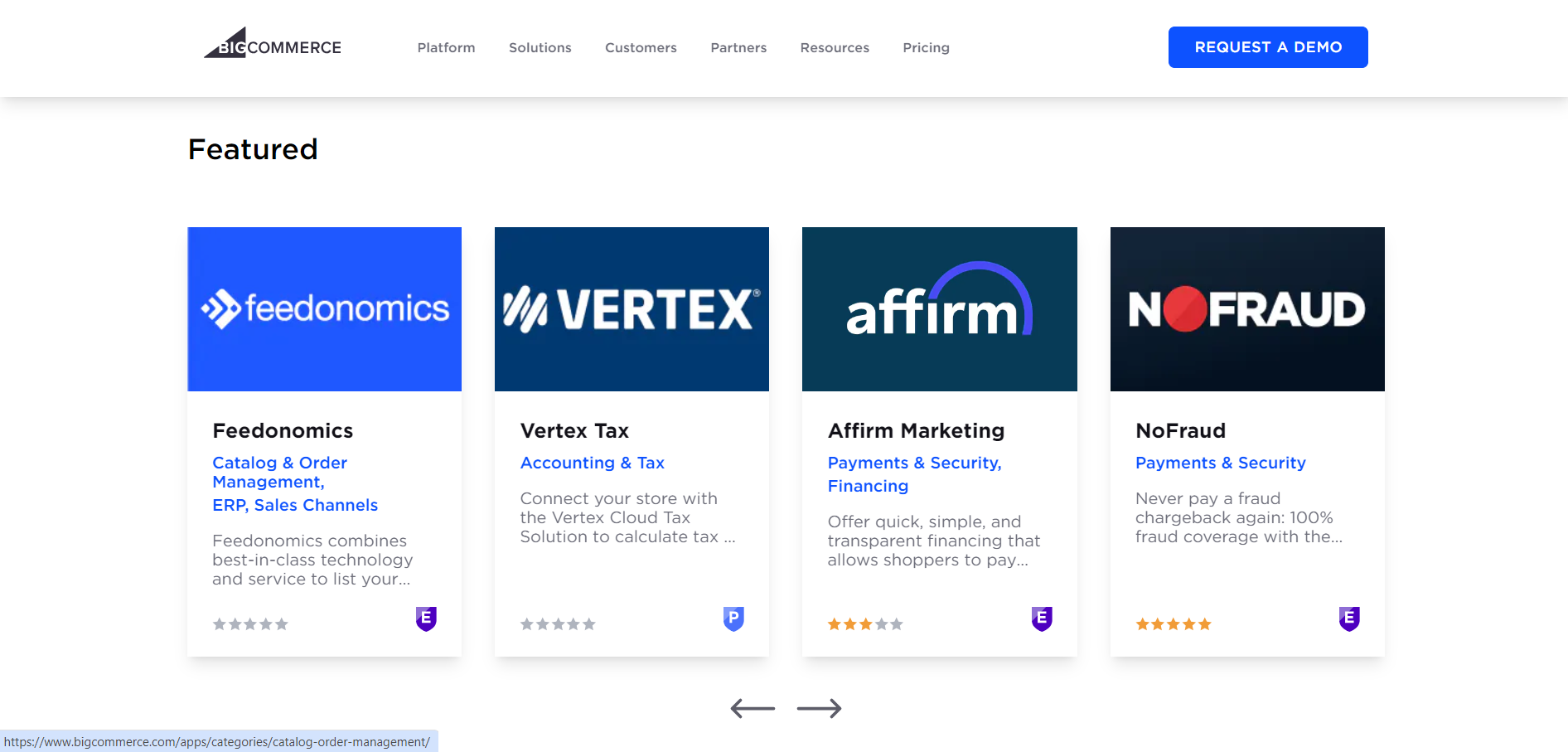
Marketing Features
Design FunctionalitiesRepresents how well each platform allows for creative design and customization of websites.Score Components:
- Template Variety (30%): Range and quality of design templates.
- Customization (30%): Flexibility and options for design alterations.
- User Interface (20%): Ease and intuitiveness of the design process.
- Responsiveness (10%): Adaptability to different devices and screen sizes.
- Innovation (10%): Unique design features and tools.
 7.8
7.8
 7.9
7.9
🏆
Overall Winner: BigCommerce
. BigCommerce edges out Webflow with a slightly higher score, indicating a more comprehensive set of marketing tools. Both platforms offer robust features, but BigCommerce’s ecommerce-focused capabilities may provide a slight advantage for online merchants.

|

|
|
|---|---|---|
|
SEO Tools |
|
|
|
Email Marketing |
|
|
|
Blogging |
|
|
|
Social Media Integration |
Simplifies content sharing and audience engagement on major social platforms |
Extensive integration for selling directly on social platforms |
|
Analytics and Reporting |
Integrates with Google Analytics for comprehensive web traffic and behavior analysis |
Comprehensive suite of analytics and reporting features |
|
Ads and Promotions |
Supports ad and promotion management through integration with platforms like Google Optimize |
Comprehensive built-in marketing tools for creating and managing various promotions |
Customer Support
Customer supportEvaluates the quality and availability of support options.Score Components:
- Response time (40%): Speed of support responses.
- Support quality (30%): Effectiveness and helpfulness of the support.
- Availability (20%): Range of support channels (phone, chat, email).
- Resource richness (10%): Quality of self-help and educational materials.
 8.3
8.3
 8.7
8.7
🏆 Winner: BigCommerce
. In the Webflow vs BigCommerce comparison, BigCommerce takes the lead with a higher customer support score of 8.7. BigCommerce offers 24/7 support through phone, email, and live chat, ensuring users can get help whenever they need it. The platform also provides dedicated phone lines for various regions and requires a support pin for personalized assistance, which enhances the support experience. Additionally, BigCommerce’s extensive knowledge base and active community forums are valuable resources for users seeking solutions and advice.
Webflow, with a customer support score of 8.3, also provides robust support options, including 24/7 live chat, email, and a community forum. Webflow’s extensive documentation and video tutorials are particularly helpful for users looking to navigate the platform and troubleshoot issues independently. For enterprise customers, Webflow offers a dedicated Customer Success Manager and priority support, ensuring that large organizations receive the assistance they need.
Overall, while both platforms offer comprehensive support, BigCommerce’s higher score and additional support features give it an edge in this category.
Security
SecurityLooks at the platforms’ security measures and data protection.Score Components:
- Data protection (40%): Safeguards for user and customer data.
- SSL and encryption (30%): Implementation of secure connections.
- Compliance (20%): Adherence to industry security standards.
- Regular updates (10%): Frequency of security updates and patches.
 7.8
7.8
 8.9
8.9
🏆
Winner: BigCommerce
. BigCommerce takes the lead in security with a score of 8.9, compared to Webflow’s 7.8. BigCommerce’s commitment to data privacy and security is evident in its adherence to international regulations like GDPR and CCPA, robust encryption techniques, secure data centers, and regular security audits. The platform also provides resources for merchants to follow best practices in security management.
Webflow, while offering robust encryption techniques and strict access controls, falls slightly short in comparison. It does, however, conduct regular updates and audits to ensure user information remains confidential and protected.
AI Capabilities
AI capabilitiesMeasures the effectiveness of AI-driven features and tools.Score Components:
- Automation efficiency (40%): Impact of AI on streamlining processes.
- Personalization (30%): AI-driven customization for users or customers.
- AI-Assisted design (20%): Role of AI in website design and functionality.
- Data analysis (10%): Use of AI in interpreting user data and analytics.
 8.3
8.3
 7.3
7.3

|

|
|
|---|---|---|
|
AI Builder |
|
Not available |
|
AI Ecommerce features |
Not available |
Personalized product recommendations, AI on-site search, AI-powered chatbots |
|
AI Content Generation |
|
AI-powered writing tools for product descriptions, ChatGPT AI Content Master by Amasty |
|
Additional AI features |
|
AI-powered writing features for product descriptions, personalized storefronts, AI-driven data analytics, Maisie AI chatbot |
🏆 Winner: BigCommerce
. BigCommerce, with a score of 7.3, offers a range of AI capabilities, particularly in the area of ecommerce. It provides AI-powered apps for personalized product recommendations, AI on-site search, and AI-powered chatbots. It also offers AI content generation features and additional AI features to enhance ecommerce operations.
Webflow, with a score of 8.3, does not currently have AI capabilities but has announced plans to introduce them in the future. These include AI-powered features for quicker website creation, smart suggestions for design elements and layouts, and AI-powered content management capabilities. However, until these features are released, BigCommerce remains the superior choice for AI capabilities.
User Management
User ManagementAssesses the platforms’ capabilities in managing user roles, permissions, and accessibility.Score Components:
- Role Customization (40%): Flexibility in creating and defining user roles and
permissions. - Ease of Management (30%): User interface and tools for managing users.
- Access Control (20%): Effectiveness of access control measures for different user
levels. - Scalability (10%): Ability to manage a growing number of users efficiently.
 8.3
8.3
 8.9
8.9
🏆 Winner: BigCommerce
. Both Webflow and BigCommerce offer robust user management features, but BigCommerce edges out with its unlimited staff accounts and more diverse roles and permissions.
- Webflow’s user management varies by plan. Core, Growth, and Enterprise plans offer unlimited editors, while others limit content editors to 3 or 10 per site. Access levels include Designer for full access and Editor for content editing. Workspace roles like Admin, Designer, and Editor ensure collaboration and security through features like the Site Activity Log and role-based permissions.
- BigCommerce allows an unlimited number of staff accounts with various roles and permissions, providing more flexibility for larger teams.
Webflow User Roles and Access Levels:
| Role | Description | Access Highlights |
|---|---|---|
| Workspace Owner | Full control over Workspace settings and member management. | Edit settings, manage billing, access/edit all sites, invite/remove members, manage permissions. |
| Workspace Admin | Similar to the owner with some restrictions. | Edit settings, manage billing, access/edit all sites, invite/remove members (except owner), manage permissions. |
| Workspace Member | Limited control focused on site interaction. | Download invoices, access/edit sites, invite members. |
| Workspace Guest | Temporary collaborators with limited access. | Access/edit sites. |
| Workspace Commenter | Limited to commenting for feedback on sites. | Create/view/resolve comments, preview sites. |
| Site Admin | Full control at the site level. | Manage permissions, delete/transfer sites, billing management, design and publish changes. |
| Can Design | Design capabilities with some restrictions on publishing. | Design in Designer, create/modify classes and components, publish changes with permission. |
| Can Design (Limited) | Restricted design capabilities for Enterprise customers. | Create new classes, modify created classes, limited publishing capabilities. |
| Can Edit | Content editing without full design privileges. | Edit text/links/images, manage assets, publish Collection items and Ecommerce products. |
| Can Comment (Site Level) | Commenting for feedback at the site level. | Create/view/resolve comments, preview sites. |
BigCommerce User Roles and Access Levels:
| Role | Description | Access Highlights |
|---|---|---|
| Sales Staff | Enables all Sales Staff permissions | Manage, edit, and add orders – Finalize manual orders with manual payments – Manage returns, capture funds, and refund orders – Manage and edit customers – Manage and edit product reviews – Manage legacy coupons and promotions – Use Image Manager |
| Sales Manager | Enables all Sales Staff and Sales Manager permissions | Includes Sales Staff permissions – Manage, create, edit, and delete products – Manage product options and categories – Export orders – Manage customer store credit and export customers – Manage blogs, brands, and various reports (Ecommerce Analytics reports, abandoned cart reports, etc.) – Edit inventory and manage channels |
| Store Administrator | Enables all Sales Staff, Sales Manager, and System Admin permissions | Includes Sales Staff and Sales Manager permissions – Manage users and form fields – Manage settings (product filtering, store settings, checkout, inventory, order notifications, etc.) – Manage payments, shipping, and tax settings – Import catalog entities and customers – Access store design tools and Page Builder – Manage customer groups – Take store down for maintenance |
| Store Owner | Includes all permissions and is the person financially responsible for the account; this role has exclusive access to various account-related features. | Full access to all permissions and features across the platform – Exclusive access to account-related features and settings not available to other roles |
| Custom | Use this option to create your own combination of permissions. You can also opt to customize one of the other roles. | Customize permissions based on specific needs – Mix and match permissions from different roles to create a unique role with tailored access |
Additional Features

|

|
|
|---|---|---|
|
SSL Certificate |
|
|
|
Custom Domain |
|
|
|
Free Custom Domain Included |
|
|
|
International Domains |
|
|
|
Mobile Responsive |
|
|
|
Page Speed |
|
|
|
Website Builder Mobile App |
|
|
|
Convert a Website To An App |
|
|
|
Website Analytics |
|
|
|
Multilingual Sites |
|
|
|
Multiple Users |
|
|
User Feedback
Webflow receives high praise for its user-friendly interface, eliminating the need for coding while offering extensive design flexibility. Users appreciate its scalability, cost-effectiveness, and seamless integration of essential features like forms and CMS. However, some users note a slight learning curve and occasional limitations, particularly in ecommerce functionalities and content management. Overall, Webflow proves to be a powerful tool for building and managing websites, offering robust features for both beginners and experienced developers, albeit with some room for improvement in certain areas like collaborative editing and content management.
User feedback on BigCommerce highlights a mix of experiences, with positive remarks on its ease of use, SEO configuration, and strong support team. However, significant criticisms include its lack of suitability for businesses with brick-and-mortar locations, due to issues with POS integration and sales tracking, as well as its inflexibility with customization and additional costs for necessary features. Additionally, concerns were raised about the platform’s steep learning curve for beginners, limitations in product variation and design options, and difficulties with order management. Despite these challenges, some users appreciate the platform’s ability to quickly launch and reliably host stores, alongside its potential for scalability and e-commerce growth.
The making of this blog
We followed a clear, step-by-step process to write and research this article.
FAQ
Which platform is better for ecommerce, Webflow or BigCommerce?
Can I use Webflow for creating informational and business websites?
How do Webflow and BigCommerce compare in terms of design and customization?
Which platform offers better customer support, Webflow or BigCommerce?
Are there any differences in hosting quality between Webflow and BigCommerce?
Which platform is more user-friendly for beginners?
Can I manage multiple users and permissions on both platforms?
How do Webflow and BigCommerce handle website speed optimization?
Which platform has better AI capabilities?
Is there a significant price difference between Webflow and BigCommerce?










